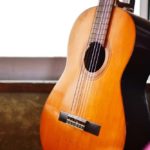"Is Classical Guitar Too Difficult?"
This is something that people who have tried classical guitar might feel at least once.
Even after nearly 20 years of playing classical guitar, I still experience it every day.
This time, from the perspective of "Why is classical guitar difficult," I have compiled the reasons and solutions for why classical guitar is challenging.
Feel free to check out specific sections that interest you using the "Table of Contents" if you find it difficult.
I hope this can be a reference for classical guitar beginners.
目次
[Reason 1] "Fingerstyle"
In classical guitar, fingerstyle playing, where you pluck the strings with your fingers, is predominant.
It differs from playing acoustic or electric guitar, where a pick is often used.
Fingerstyle playing has its challenges, including:
- Right-hand muting techniques
- Finger placement and plucking techniques
- Nail angle adjustment and maintenance
From my own experience, fingerstyle playing feels easier, but listening to others, these aspects are often considered difficult.
Many people also find techniques like arpeggios and tremolos challenging, and they perceive classical guitar as having a high learning curve.
It involves more coordination and control, and it can be seen as "costly" in terms of effort for producing a single note, compared to pick playing. Honestly, the only solution here is practice.
However, maintaining your nails to prevent snagging can significantly enhance playability.
Additionally, accepting that classical guitar can be tough and that it's normal to struggle can help ease your mindset.
[Reason 2] Playing Melody, Chords, and Bass Simultaneously
This ties into the previous "Fingerstyle" discussion, but classical guitar pieces are primarily composed with the idea of "playing melody, chords, and bass simultaneously" by a single performer.
This is similar for acoustic guitar solo, but the primary playing styles for acoustic and electric guitars are as follows:
- Acoustic (Strumming while singing)
Strumming chords on the guitar while singing.
- Electric (Guitar part in a band)
Leaving singing and bass parts to the band and primarily playing strumming or single-note melodies.
Classical guitar pieces require the performer to handle melody, chords, and bass all on their own, making it quite demanding.
When showing videos to people who haven't heard much solo guitar before, it's common to receive comments like, "Are they really playing all that by themselves?"
This reaction highlights the difficulty of simultaneously performing these roles.
Personally, I have experience playing bass in guitar ensembles and bands, but compared to those, solo guitar work takes approximately two to three times longer to complete a piece.
Of course, this is understandable, considering it involves playing three roles: melody, bass, and chords.
So, even if it takes longer to master than acoustic or electric guitar, it's crucial to think of it as "several times harder" and not get discouraged (even though it can be tough).
[Reason 3] Wide Fretboard
For those who started with acoustic or electric guitars, the wider fretboard of a classical guitar may feel "difficult to play."
Especially since electric guitars often have low string tension, making them easier to fret.
In contrast, classical guitars, due to their acoustic nature, have higher string tension, which can be challenging for those transitioning from electric guitars.
However, you can alleviate this issue with the following measures:
- Lower the action of the guitar (string height above the fretboard)
- Use light-tension strings
As someone who initially played classical guitar, I find acoustic guitars to require the most finger strength.
Nevertheless, implementing these strategies helped reduce hand fatigue, even though I was prone to developing tendinitis.
[Reason 4] The need for interpretive skills in music
To play classical guitar pieces beautifully, it's essential to interpret and reflect the intentions of the music and the sheet music.
For instance, it may require insights like, "This sequence of notes belongs to the same chord, so it's better to finger it in a way that extends the sound," or "There are some difficulties in this sheet music, so let's make some adjustments."
However, these days, you can find classical guitar sheet music with tablature (TAB) included, making it much easier for beginners to play.
Nevertheless, TAB notation has some disadvantages:
- It may make it harder to recognize the notes individually.
- It might be challenging to determine which notes to sustain and for how long.
- It doesn't help improve your ability to read sheet music.
With TAB notation, the answers are already provided, and this can hinder the development of these analytical skills.
It's worth noting that some commercial TAB sheets don't always offer the optimal fingering.
Although you can develop these analytical skills with time, it can be challenging for beginners.
As a solution, when using TAB notation, try to practice by asking yourself, "Would I really play it this way?"
This habit can be effective.
Keeping in mind the potential drawbacks of TAB notation and integrating critical thinking into your practice can help you play pieces more beautifully.
[Afterword] Recommended practice and information for classical guitar beginners
I've summarized the reasons why classical guitar can be challenging.
Although it might seem like there's a lot of negative information, I genuinely believe that classical guitar provides unique benefits that you can't find elsewhere.
While band and ensemble music may offer a more straightforward way to enjoy music, the sense of accomplishment when you complete and record a piece is a special reward in the world of classical guitar.
Even though it's tough, as you understand that it's a challenging endeavor, you can make progress bit by bit.
I encourage you to take on the challenge of classical guitar.
I've provided some basic practice videos and information for beginners who find "classical guitar to be difficult."
Please feel free to check them out for reference.
Thank you for reading to the end.
Top 10 Recommended Solo Classical Guitar Pieces for Beginners


